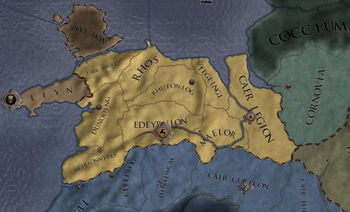Kingdom of Gwynedd
The Principality or Kingdom of Gwynedd (Latin: Venedotia or Norwallia; Middle Welsh: Guynet,) was one of several successor states to Rome which emerged in 5th-century Britain during the Coming of the Saxons. Based in northwest Wales, the rulers of Gwynedd repeatedly rose to preeminence and were acclaimed as "King of the Britons."
Although technically a vassal to the High King of Prydain, Cunedda Wledig, the current King of Gwynedd, has declared his independence and maintains sufficient military force to ensure that this does not change in the foreseeable future.
Like most of Wales in the 5th Century, the Kingdom of Gwynedd utilizes Agnatic Elective Gavelkind as its succession law: The titles of the ruler are divided among his children and the primary heir, who is elected from among the members of the ruling dynasty. The law defaults to Primogeniture. You get no Prestige penalty for having unlanded sons and can have a 30% larger demesne. Destruction of titles unader any form of Gavelkind succession is not allowed. On succession in kingdoms and empires, new kingdoms might be created for younger sons if possible. Junior heirs always get the choice to declare independence without a war. Only males can inherit.
